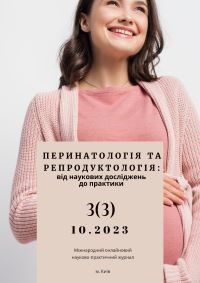Repeated laparoscopy is at complications after gynaecological endoscopic operations
Keywords:
laparoscopy, laparotomy, endoscopic surgery, abdominal complications, parameters of diagnostic valueAbstract
DOI: 10.52705/2788-6190-2023-03-7
УДК 618.1-089:616.381-072.1-06-07-08
The objective. To analyse the results of repeated laparoscopy for the patients of gynaecological type with suspicion on intra-abdominal postoperative complications.
Materials and methods. 42 patients (middle age - 46±11,3 years) in which postoperative abdominal complications after surgical treatment of different gynaecological diseases needed the repeated operations took part in research. Depending on the method of the repeated interference patients are up-diffused on 2 groups: basic (n=20) are women in which for the correction of postoperative complications used laparoscopy only; control (n=22) are women in which for the correction of postoperative complications during diagnostic laparoscopy there were the proposed testimonies to relaparotomy. In 8 patients of control group relaparotomy is executed at once. A complex inspection was conducted all patients with application of clinical, instrumental and laboratory methods of research. Groups were homogeneous on age and by the structure of operations, executed on the organs of small pelvic, and statistically comparative.
Results. During research the analysed results of repeated laparoscopy of 34 patients of gynaecological type are with suspicion on intra-abdominal postoperative complication. For all patients of basic group (47,6%) laparoscopy appeared the unique and eventual method of treatment of postoperative complications, here in 7 women repeated реlaparoscopy was used from 2 to 4 times, and in 13 laparoscopy it is conducted singly. In the group of control (52,3%) to 10 patients during diagnostic laparoscopy were exposure of testimony to relaparotomy, for 4 patients of possibility of operating brigade and laparoscopic technique allowed to execute some elements of operation and complete it minilaparotomy access, and in 8 patients relaparotomy is executed at once.
Peritonitis and intra-abdominal bleeding predominate in the structure of early abdominal complications. Application of videolaparoscopic method allowed in 28,6% patients with the poured out peritonitis successfully to liquidate the developed complication, remove his source and conduct санацію of abdominal region. Laparoscopic hemostasis is successfully executed in 7 patients.
By comparison to standard, the use of videoendoscopic method allowed to improve the indexes of diagnostic value: to increase the level of sensitiveness in 1,07 times, in 1,39 times of specificity and in 1,11 times of exactness of diagnostics.
Conclusion. On the whole in an early postoperative period concerning the suspected complications it is executed 47 реlaparoscopy, that is explained by the leadthrough of programmable sanation of abdominal region by application of dynamic laparoscopy for control of motion of intra-abdominal complication. On the basis of analysis of the investigated material we are offer general testimonies and contra-indications to the leadthrough of реlaparoscopy in an early postoperative period with the purpose of diagnostics and treatment of postoperative complications. Substantiating each of points, we followed the real possibilities of method in general clinical practice, which in the row of cases act after the efficiency of relaparotomy.
Downloads
Published
How to Cite
Issue
Section
License

This work is licensed under a Creative Commons Attribution-ShareAlike 4.0 International License.


